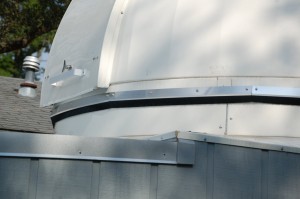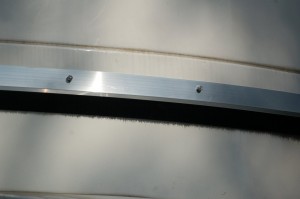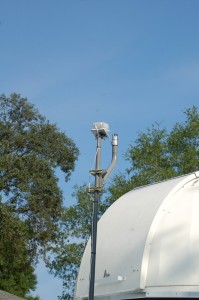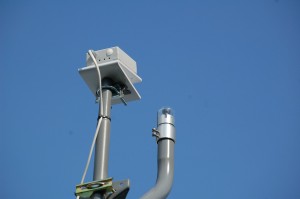The long three day 4th of July weekend was spent whittling down the observatory to-do list. Although there is still a small amount of insulation to be installed in the control room, the long weekend allowed the one multiple day task to be done in the shortest time. Although I have not had any rain come in the dome since I re-sealed the skirt corners, I am concerned with the approaching hurricane season. In order for the dome to rotate, the movable part of the dome cannot be totally sealed to the stationary portion. This means rain or dust can get in but the construction of the dome does force a somewhat circuitous route. Currently dust and the perennial yellow pine tree pollen do make their way in. I’m afraid that the wind of a tropical system would do the same thing with rain which is, of course, more damaging and harder to clean up.
Wandering the internet led me to an observatory in Idaho that had the same problem with dust. The owner solved the problem by installing brush seals around the periphery of the rotating portion of the dome. The specific model underhangs the edge of the dome support ring and rides against the base ring providing a flexible seal. I need to thank the director of the Eagle Rock Observatory for his help. I e-mailed some questions in the middle of December as to size and measurements. He put on his snow-shoes and slogged out to the observatory and made measurements that made my job much easier. Thanks, Trevor.
I have had the brush seals sitting in the control room since January waiting for an opportune time and now was it. I had scaffolding delivered Friday. And since I can’t be in two places at once, I called on my N-scale model railroad partner Bill and we started Saturday morning. We accomplished the ‘engineering’ part of the task and installed the first strip of the seal by noon, but it had gotten very hot by then and we called a knock-it-off. On Sunday we only worked again to noon and then finished up Monday morning. I took the opportunity of a second set of hands to install the dome soffit. It seals the non-movable portion of the shutter to the dome support ring. And since I stretched the shutter motion cabling by attempting to open the shutter when it was locked, we took the time to adjust the rigging. Thanks again Bill.
I also installed some more automation equipment. A cloud detection system came with the dome’s automation package. It consists of an IR detector to measure the temperature of the sky, a rain detector, a light detector to measure the sky brightness and an ambient temperature sensor. Together they can, when properly adjusted, determine if it is safe to open the dome. If not, they can command the dome to close to protect the equipment inside. The software’s default values for the IR subsystem are for a much more northerly location and as such it has a problem with the high temperatures here. The haze associated with the proximity of the gulf is also causing mis-classifying the sky condition. The new to-do list task is to come up with the appropriate values to plug into the algorithm so the cloud system can be brought fully on-line.
The cloud detector set is the rectangular object on the top of the straight portion of the support pole. It is set at that angle to allow rain to run off the sensors.
The last thing I get to report is the addition of a sky camera. It is a Moonglow Technologies All Sky Cam. It is a small color CCD housed in a glass dome pointed straight up. It is quite sensitive at night and provides a good view of any approaching clouds. Currently, the images are only downloaded to WeatherUnderground on the observatories weather page. If you want to see, click on the observatories station code “KFLVALPA4” in the current weather conditions side-bar widget. Getting the imagery and the cloud data on to the web page is now a new task on the to-do list.
The software package that comes with the camera is quite comprehensive. It allows you to combine the stills into ‘movies’ and will allow viewing the imagery using several different projections. As can be seen below it will ‘un-wrap’ the standard fish-eye view. North is at the left edge and the moon is visible almost directly to the south.




